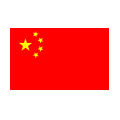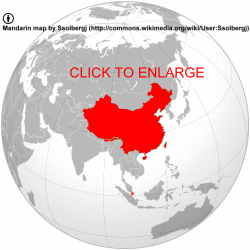Learn Mandarin Online with Rocket Chinese |
|
FTC Affiliate Disclosure:
If you purchase through links on this Web page, NetResult
Web Marketing receives a commission from the sale. You do
not pay higher prices when purchasing through this site. We promote only
products we believe will be of benefit to you. Your support is appreciated.
Thank you.
Where is Mandarin Spoken?Mandarin Language HistoryIn Chinese linguistics, Mandarin (pinyin: Guānhuà;
literally "speech of officials") refers to a group of related
Chinese dialects spoken across most of northern and southwestern China.
Because most Mandarin dialects are found in the north, the group is less
commonly referred to as the "northern dialect(s)." There are
pronounced regional variations in pronunciation, vocabulary and grammar.
A northeastern-dialect speaker and a southwestern-dialect speaker can
hardly communicate except through the standard
language, mainly because of the differences in tone. Nonetheless,
the variation within Mandarin does not compare with the much greater
variation found within several other varieties
of Chinese, and this is thought to be due to a relatively recent
spread of Mandarin across China,
combined with a greater ease of travel and communication compared to
the more mountainous south of China.
When the Mandarin group is taken as one language, as is often done in academic literature, it has more native speakers than any other language, nearly a billion people. For most of Chinese history, the capital has been within the Mandarin area, making these dialects very influential. Mandarin dialects, particularly the Beijing dialect, form the basis of Standard Chinese, which is also known as "Mandarin." Chinese (hànyǔ or zhōngguóhuà ) comprises many regional language varieties sometimes grouped together as the Sinitic languages, the primary ones being Mandarin, Wu, Cantonese, and Min. These are not mutually intelligible, and even many of the regional varieties (especially Min) are themselves composed of a number of non-mutually-intelligible subvarieties. As a result, Western linguists typically refer to these varieties as separate languages. Standard Chinese or Modern Standard Chinese, also known as Mandarin or Putonghua, is the official language of the People's Republic of China and Republic of China (Taiwan), and is one of the four official languages of Singapore. The phonology is based on the Beijing dialect. The vocabulary is drawn from the large and diverse group of Chinese dialects spoken across northern, central and southwestern China, which is also known as Mandarin Chinese. The grammar is standardized to the body of modern literary works that define written vernacular Chinese, the colloquial alternative to Classical Chinese. The name "Mandarin" originally referred to the language of the imperial court in Beijing...LEARN MORE See and Hear Chinese CultureChina's Contribution to World Culture:  National Geographic Great Wall Of China [0:47] National Geographic Great Wall Of China [0:47] Chinese
Treasure Fleet - Adventures of Zheng He : Documentary [1:33] Chinese
Treasure Fleet - Adventures of Zheng He : Documentary [1:33] Forbiddencity
documentary [1:30] Forbiddencity
documentary [1:30] YouTube - Forbidden City Channel YouTube - Forbidden City Channel The
Art of War Sun Tsu Full Documentary. (Educational). [1:30] The
Art of War Sun Tsu Full Documentary. (Educational). [1:30] The
Art of War - Audiobook [1:54] The
Art of War - Audiobook [1:54] Chinas
Ghost Army The Terracotta Army [0:45] Chinas
Ghost Army The Terracotta Army [0:45] Secret
World Of Wellness: Ancient China [0:52] Secret
World Of Wellness: Ancient China [0:52] The
First Emperor The Man Who Made China [1:42] The
First Emperor The Man Who Made China [1:42] God
in Ancient China [1:00] God
in Ancient China [1:00] Old
Mandarin Song Old
Mandarin Song Siti Nurhaliza sings Mandarin song - zheng
fu Siti Nurhaliza sings Mandarin song - zheng
fu Gackt
in Beijing Gackt
in Beijing Top
Mandarin - 吻別 - Wen
Bie Top
Mandarin - 吻別 - Wen
Bie Top
Mandarin - 寶貝對不起 - Bao
Bei Dui Bu Qi Top
Mandarin - 寶貝對不起 - Bao
Bei Dui Bu Qi Zhang
Liang Ying: Chinese woman with an amazing voice, versatility & range Zhang
Liang Ying: Chinese woman with an amazing voice, versatility & range Dao
Lang 刀郎 - Mandopop
Mandarin Song [HD] Dao
Lang 刀郎 - Mandopop
Mandarin Song [HD] Black
guy singing a Chinese
Mandarin song Black
guy singing a Chinese
Mandarin song "Bamboo
Under the Moonlight" by Gong Yue "Bamboo
Under the Moonlight" by Gong Yue Tashi
Pe Tendrel (Song of Auspiciousness / Prosperity) Tashi
Pe Tendrel (Song of Auspiciousness / Prosperity) Mandarin
Dangdut 荡突舞 Huang
Jia Jia Na Yi Ye Malam Itu Mandarin
Dangdut 荡突舞 Huang
Jia Jia Na Yi Ye Malam ItuChinese Culture Today:  This
is China—awesome video! This
is China—awesome video! National
Geographic channel lost in china silk road [0:47] National
Geographic channel lost in china silk road [0:47] Mysterious
China - Secrets of the Silk Road [1:30] Mysterious
China - Secrets of the Silk Road [1:30] Chinese build record breaking bridge Chinese build record breaking bridge CHINA Launches FASTEST TRAIN SERVICE IN WORLD. Amazing !! 350km/h CHINA Launches FASTEST TRAIN SERVICE IN WORLD. Amazing !! 350km/h Tifa Riding the Bullet Train in China [0:10] Tifa Riding the Bullet Train in China [0:10] [HD] Official China High-Speed Rail Promotion Video [HD] Official China High-Speed Rail Promotion Video Guilin
a True Beautiful Place Guilin
a True Beautiful Place Travel
Guide - China Travel
Guide - China Beijing Panoramas—magnificent! Beijing Panoramas—magnificent! Modern
China: Pictures of Beijing, Shanghai, Hong Kong, and more Modern
China: Pictures of Beijing, Shanghai, Hong Kong, and more Shanghai,
China -- the Most Beautiful City in the World Shanghai,
China -- the Most Beautiful City in the World Learning China's Provinces and Regions Learning China's Provinces and Regions [Beautiful China HQ] Inner Mongolia Province [Beautiful China HQ] Inner Mongolia Province [Beautiful China HQ] Jilin Province [Beautiful China HQ] Jilin Province [Beautiful China 2011-01-31 1080HD] The Great Wall of China [Beautiful China 2011-01-31 1080HD] The Great Wall of China [Beautiful China 2011-04-09 1080HD] The Vibrant City of Beijing [Beautiful China 2011-04-09 1080HD] The Vibrant City of Beijing [Beautiful China 2011-01-06 1080HD] The Imperial Palace of Beijing [Beautiful China 2011-01-06 1080HD] The Imperial Palace of Beijing [Beautiful China HQ] Hebei Province [Beautiful China HQ] Hebei Province [Beautiful China HQ] Shandong Province [Beautiful China HQ] Shandong Province [Beautiful China 720HD] Jiangsu Province [Beautiful China 720HD] Jiangsu Province [Beautiful China 2011-04-05 720HD] Ancient Suzhou Gardens [Beautiful China 2011-04-05 720HD] Ancient Suzhou Gardens [Beautiful China 720HD] Anhui Province [Beautiful China 720HD] Anhui Province [Beautiful China HQ] Shanghai City [Beautiful China HQ] Shanghai City [Beautiful China HQ] Zhejiang Province [Beautiful China HQ] Zhejiang Province [Beautiful China HQ] Romance of the West Lake [Beautiful China HQ] Romance of the West Lake [Beautiful China HQ] Jiangxi Province [Beautiful China HQ] Jiangxi Province [Beautiful China HQ] The Dragon and Tiger Mountain / Jiangxi Province [Beautiful China HQ] The Dragon and Tiger Mountain / Jiangxi Province [Beautiful China HQ] Fujian Province [Beautiful China HQ] Fujian Province [Beautiful China HQ] Hunan Province [Beautiful China HQ] Hunan Province [Beautiful China 720HD] Henan Province [Beautiful China 720HD] Henan Province [Beautiful China HQ] Ningxia Province [Beautiful China HQ] Ningxia Province 【Beautiful China 720HD】The Magnificant Scenery of Qinghai Lake 【Beautiful China 720HD】The Magnificant Scenery of Qinghai Lake [Beautiful China 720HD] Shaanxi Province [Beautiful China 720HD] Shaanxi Province [Beautiful China 720HD] Sichuan Province [Beautiful China 720HD] Sichuan Province [Beautiful China 2010-10-03 1080HD] Heavenly Scenery of Jiuzhai Valley [Beautiful China 2010-10-03 1080HD] Heavenly Scenery of Jiuzhai Valley [Beautiful China HQ] Yunnan Province [Beautiful China HQ] Yunnan Province [Beautiful China HQ] Yunnan Xi Shuang Ban Na [Beautiful China HQ] Yunnan Xi Shuang Ban Na [Beautiful China 720HD] Dali Yunnan [Beautiful China 720HD] Dali Yunnan Chinese
Culture (English Version) Chinese
Culture (English Version) Chinese
Music Chinese
Music Chinese
music - traditional pipa solo by Liu Fang Chinese
music - traditional pipa solo by Liu Fang Famous
ancient guqin masterpiece called "Guangling
San" performed by Liu Fang Famous
ancient guqin masterpiece called "Guangling
San" performed by Liu Fang Chinese
music: Flute, Banjo, Citer and Erhu Chinese
music: Flute, Banjo, Citer and Erhu Most Beautiful Chinese Music You will ever hear Most Beautiful Chinese Music You will ever hear Beautiful
Chinese Music 【1】of
19 Traditional Beautiful
Chinese Music 【1】of
19 Traditional Chinese
Traditional Song [0:09] Chinese
Traditional Song [0:09] Buddhism Art Dance (Thien Thu Thien Nhan)—amazingly performed by The Chinese Disabled Performing Arts Troupe (they are deaf) Buddhism Art Dance (Thien Thu Thien Nhan)—amazingly performed by The Chinese Disabled Performing Arts Troupe (they are deaf) Chinese
Disabled Arts Troupe (2008) perform for the Jerry Lewis Muscular Dystrophy Association Telethon in Las Vegas—beautiful, amazing, remarkable! Chinese
Disabled Arts Troupe (2008) perform for the Jerry Lewis Muscular Dystrophy Association Telethon in Las Vegas—beautiful, amazing, remarkable! National
Chinese Anthem (with English subtitles) entitled March
of the Volunteers (also known as Yi Yong Jun Jin Xing Qu) National
Chinese Anthem (with English subtitles) entitled March
of the Volunteers (also known as Yi Yong Jun Jin Xing Qu) Sung
by Paul
Robeson: Arise
("Chee Lai") - National Anthem of People's Republic
of China Sung
by Paul
Robeson: Arise
("Chee Lai") - National Anthem of People's Republic
of ChinaMandarin Immersion Fun
LOVE TRANSCENDS
THE BARRIERS OF LANGUAGE ™ |
||||||||||||||||||||||||||||||||||||||||||||||||||||||||||||||||||||||||||||||||||||||||||||||||||||||||||||
| Return to top. |
 |
||||||||||||||||||||||||||||||||||||||||||||||||||||||||||||||||||||||||||||||||||||||||||||||||||||||||||||







